From: Mike K4ICY (MAJIKMIKE)
Hi guys!
I'm still alive and kicking, and believe it or not, I still enjoy Moi about every day. It's been especially handy at work where 3D type and other implements are a cinch.
This one is a concept piece blending the layout of a vintage tube-type radio with that of a city. It's taken about two weeks to complete from thought to rendering and I put way too much detail into some of the elements.
Warning: Everything is NOT to scale! ;-)
I think SU would have made it easier to create the city elements, but I haven't used that program in a few years, and frankly, Moi is just too much fun not to use.
Each of the foreground buildings include interior floors, walls and appropriate lighting!
On the inner block, the two leftward buildings are apartments and the strange looking one is some type of academic center. The small park is a general-use municipal center, including the same lamp posts found on Bourbon Street in New Orleans... (I've got a couple of assets built over time)
The Moi file is about half a gig in size and not so easy to manipulate - this because of too many fillets.
I only laid out what was necessary for the camera view I wanted.
I hard part was rendering. Since I am not made of money and I still haven't grasped Blender, I used the clunky and buggy old program Kerkythea (Boost), which is free.
Plus, I'm a believer in the Metropolis Light Transport (BPT) rendering engine which suits my style of using as many illumination elements as possible.
I suppose, getting into something more powerful like Cinema 4D is still far off for me. But even with this rendering in Keryky, I've learned so much more about using materials and layout.
For the record, I am NOT completely satisfied with my result. My glass materials are a struggle and I'm not using a good program that can handle high polys as well as mastering materials and UV mapping, like V-Ray. Plus, I'm missing a lot of elements I desired to include, including people and vehicles. Kerky just couldn't handle much more without crashing.
I'm also a little (and only so little) disillusioned by the lack of instancing or grouping in Moi. Sorry Michael, It didn't become a wish until I actually ran into the need, yes, the material selections and naming helped - but that's not to say that Moi has every advantage that dwarfs this minor inconvenience. I'm with you on your philosophy concerning Moi's strong suits as it is perfectly crafted for what it does well. I mentioned that this type of layout was best suited for a poly app like SU.
I still would be nice to say, "hey, I don't like the design of a street lamp that I have 40 copies of, positioned ever so nicely... lets fix that quick."
But how often does one need to blend custom industrial design elements like electronics and mechanics with architecture? Ha!
Anyways, I would still like to tweak a few more elements on this one, but the main goal of getting the next cover page for the newsletter is done, and I am satisfied.
You can see that I've included the audio speaker from my tutorial.
Speaking of tuts, I know it's been over a year since my last one... I'm itching to do another one, but life is way different for me now, and who knows. ;-)
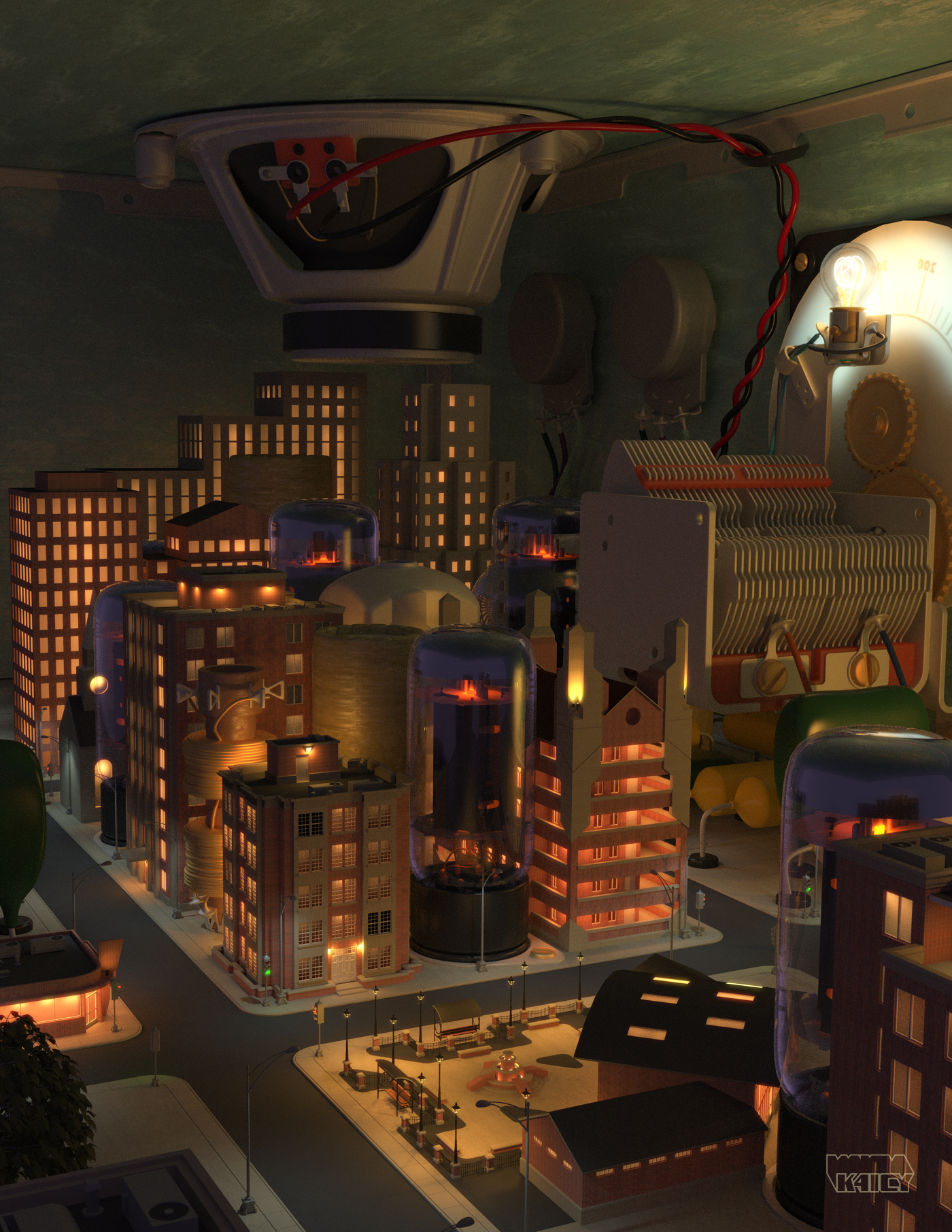
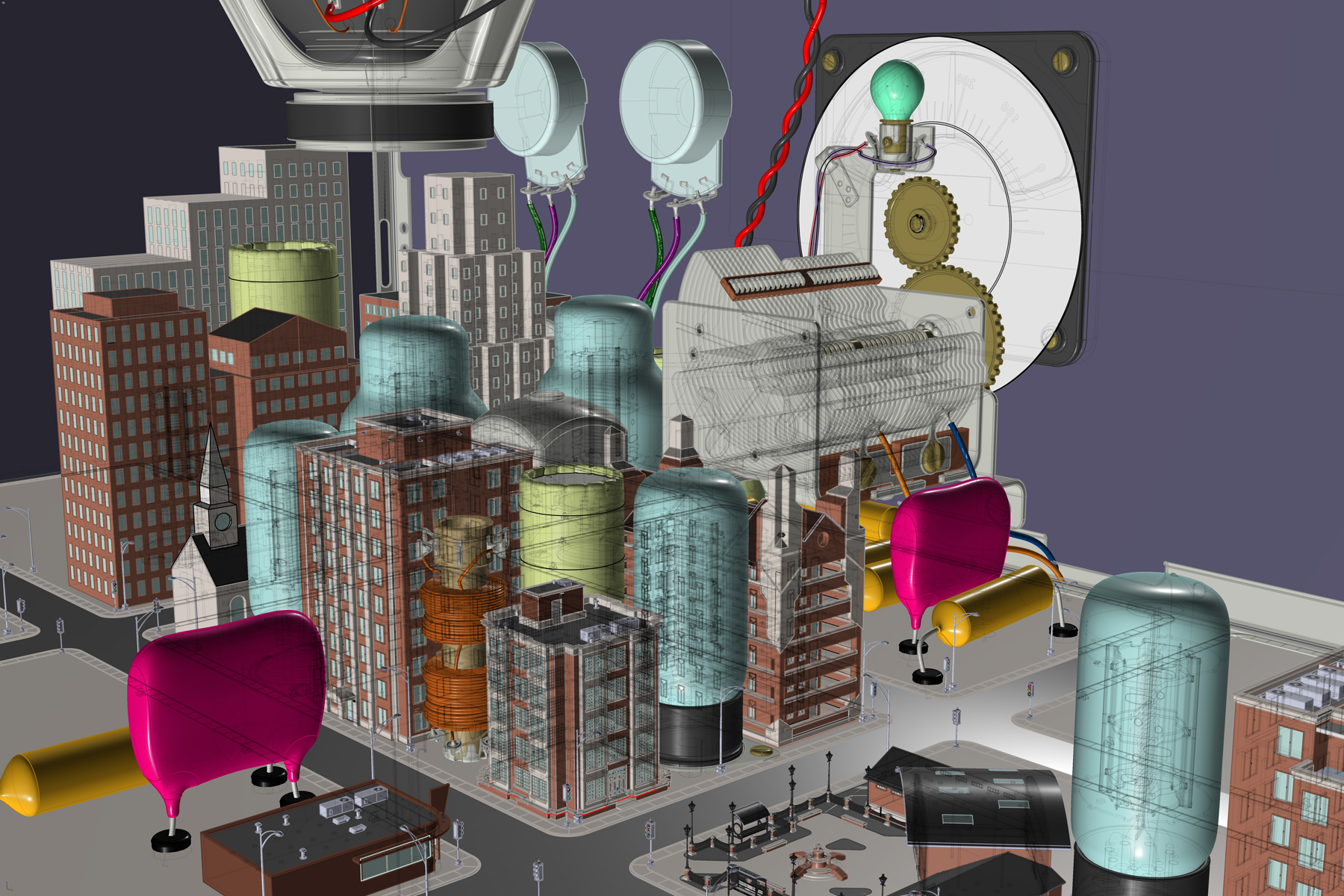
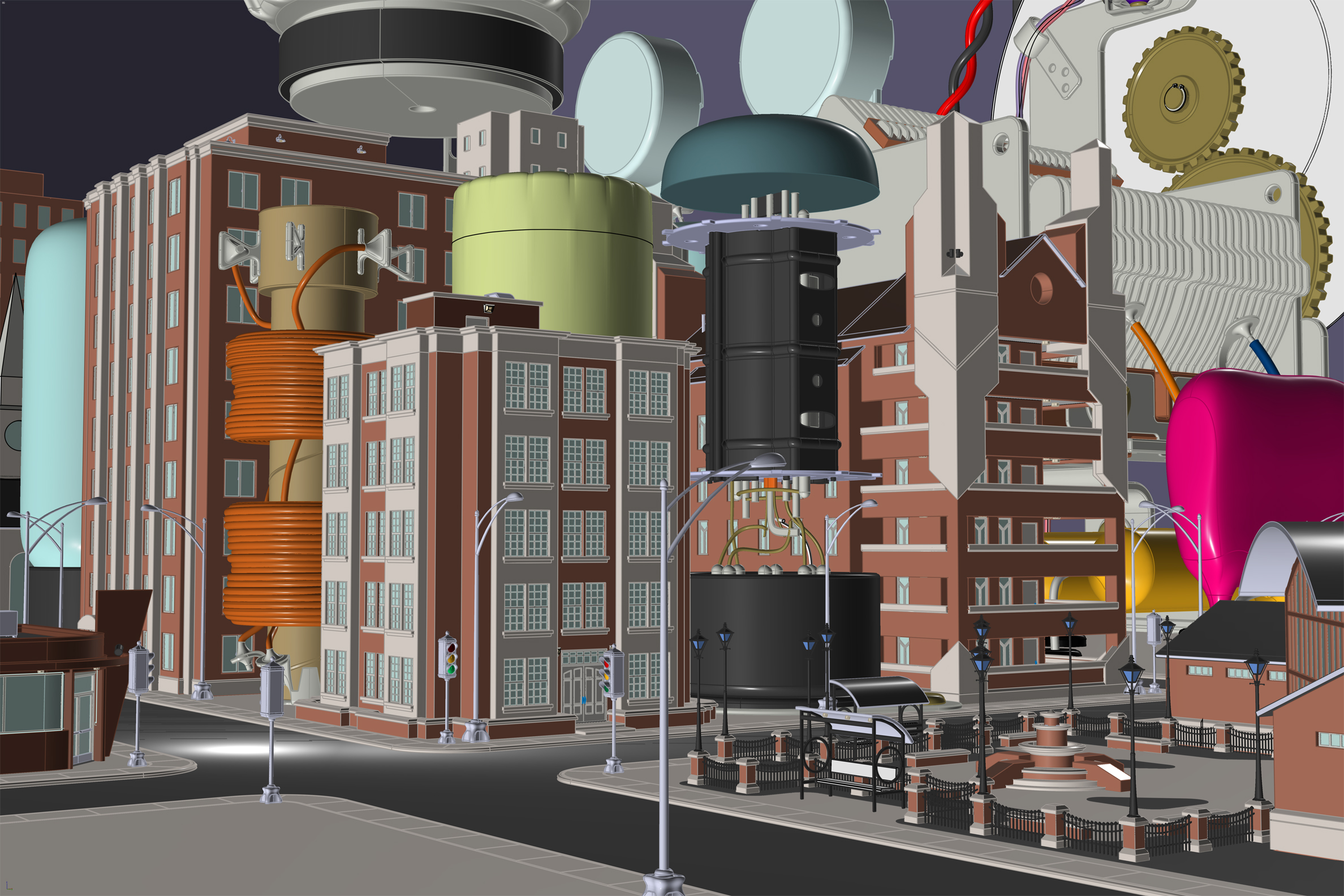
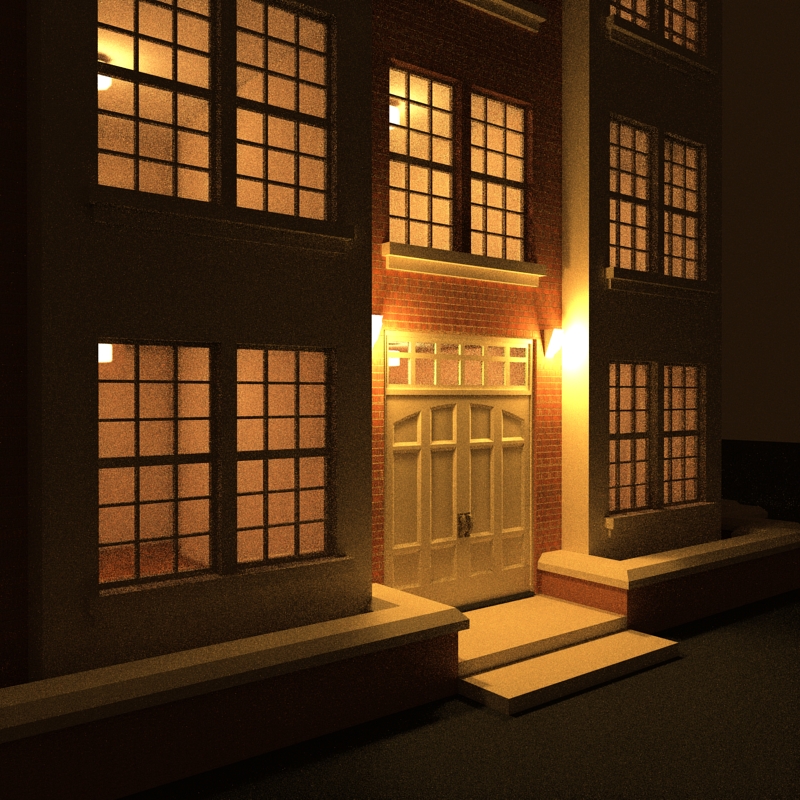
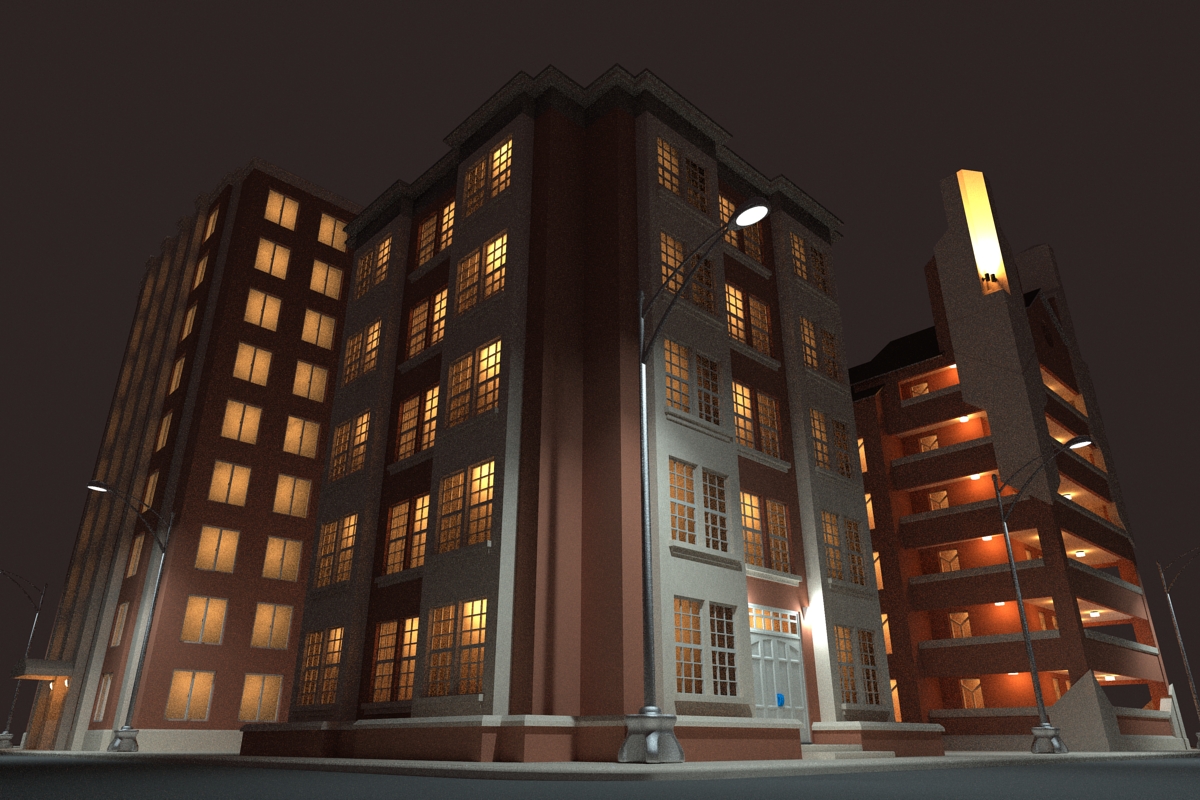
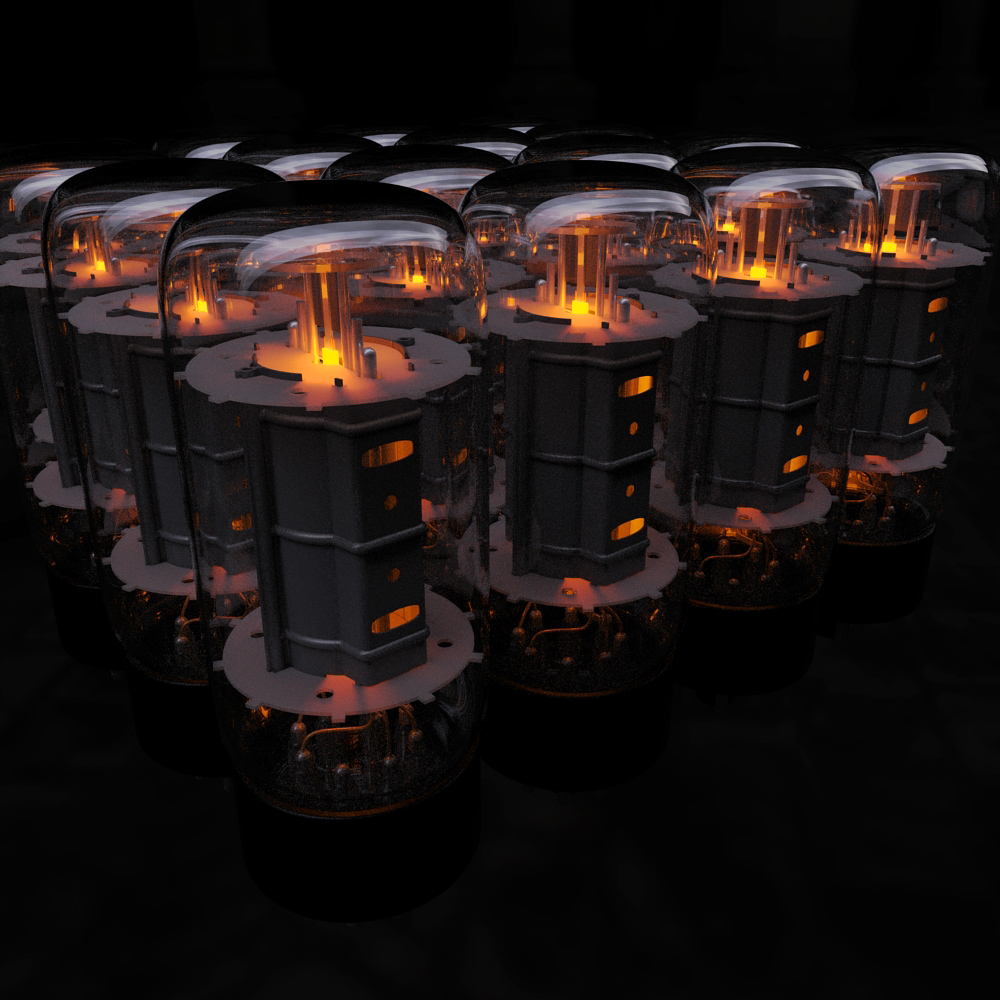
From: BurrMan
Nice Majik!!!! I've been wanting to do some archi stuff for fun... Maybe this will inspire me.....
From: ed (EDDYF)
Nice concept and execution! Reminds me of the Heathkit GR64 shortwave radio I built at age 12. No stinkin' transistors - we're talkin' vacuum tubes, Weller solder gun, and leaded solder fumes!
Hey - you've got to do more tutorials. Gotta see what you do with the subD script (besides that awesome steering wheel)
Ed
From: Frenchy Pilou (PILOU)
Magic mood internal Radio City! Bravo!
Have you try also free Twilight2 "Hobby" against Kerky ?
http://twilightrender.com/index.php/what-is-twilight/hobby-vs-pro
From: Michael Gibson
Hi Mike, great to hear from you and that looks fantastic!
- Michael
From: TpwUK
Excellent work - I love toon style when combined with great imagination, well done Mike
Martin
(TpwUK)
From: eric (ERICCLOUGH)
Wow ... good work!
eric
From: Ronamodeler (RON_A)
Mike,
I know you aren't fishing for compliments, but these are fantastic! Great concept, and wonderful execution! Inspiring...
Ron
From: Mike K4ICY (MAJIKMIKE)
Thank you all very much!
Nah, need no applause ;-) but it's nice to share and Moi is still so much fun to use even after years, and I think everyone here agrees.
Pilou, I'll look into Twilight. I know it works through SU, which is a pretty friendly app for pre-render layout, but I'd like to see more specs, such as its strengths with materials, and what types of rendering methods it uses. Their gallery stuff looks great.
...Twilight supports MLT rendering in "Interior" and "Interior+" mode settings, (which supports a nearly unlimited number of light sources, associated shadows and caustics) though, I don't know if MLT with bidirectional path tracing is supported which yields superior results in indirect lighting.
And another question, the last version of SU I used was 2011, and even that had a limit on the number of polys. Many stand-alone rendering apps will handle mass quantities.
Nonetheless, it's worth looking into.
From: Mike K4ICY (MAJIKMIKE)
So Kerkythea, of course, has really become two commercially-available programs; Thea Render and Twilight.
Twilight is available really cheap for $95. It's an SU plugin which is perfect for SU users. They don't give too many details on their site as far as features or performance, but it does employ an unbiased Metropolis Light Transport engine perfect for internal and product scenes.
I am not aware of how advanced its material editing capability is but I assume that it's comparable to Kerky.
Thea Render is available for $215 (€195) and also comes as a SU plugin but their Studio version looks pretty nice, which is great for just doing work out of Moi.
It believe its "TR2" mode is the same MLT BiPT engine. There is something mentioned about being able to use your GPU to speed up rendering as well.
I'm not sure if its materials are the same as in Kerky with the ability to intermingle layers of material instances. They say they have "displacement" which is awesome! That's one thing I like about those V-Ray materials. I need to find a very in-depth Thea materials guide to feel good about it, though the interface looks very graphical and intuitive.
Did someone say one time that you could rent out render farm nodes? Well that's beyond my scope, but I do have to upgrade from the free app sooner or later.

From: chippwalters
Nice job, Mike. I, too, have similar problems as you. When I'm in MoI I don't want to use other programs, and when I'm in SU mode, I enjoy it's features and dread switching back to MoI as I fear having to 're-learn' some of the more esoteric MoI stuff. One thing which has helped is I've tried mapping my shortcuts between SketchUp, MoI and Lightwave to the same same keys. So, no matter what app I'm using, I'm using T for translate, Y for rotate, P for Poly, etc.. It really helps.
I've yet to find export settings that work PERFECT from MoI to SU-- especially for big models with lots of curved surfaces. For some reason OBJ export works great for Keyshot, but hiccups on SketchUp with funky TINY polys which take forever to clean up. I think it has something to do with SU's 'auto merge' poly routines.
Speaking of Keyshot, while it may be out of your price range, but it really is dead simple and works great with MoI. Their newest version, still in beta, is pretty sweet and may soon compete with Vray for simple interiors. It's still lacking many of the basics, like atmospheric haze and true displacement, but for product rendering it can't be beat.
Thanks for sharing and I look forward to your next tute!
From: Mike K4ICY (MAJIKMIKE)
I've been seriously looking into Thea Render (Studio.) They let you try out the interface as a demo and the Materials interface is pretty interesting.
You can layer and mix materials on a base level including main types for Solid, Glass, SSS, Thin Glass, and etc. while being able to tweak the attributes in various more complex sub-layers employing bitmap textures for nearly every function. Thea even supports true displacement. The TR render modes are even un-biased MLT engines, perfect for lighting.
Thea is perfect for me now because it is basically the upgrade of Kerkythea which I am used to.
Since I'm not made of money though, it'll have to wait a bit.
I've run into one caveat with Thea having to do with making a certain material.
It's not a deal-breaker, but you know, when you really want a certain result, hangups can eat you alive.
Fluorescent acrylic has always been a favorite material of mine. Somehow, the edges of anything made from this plastic glowed in neon brilliance.

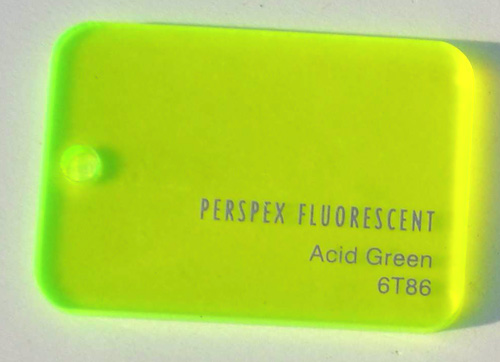
The "glowing edges" effect is achieved by two parts; first, light entering and moving through the acrylic is bounced around inside the same way it does in a fiber-optic material.
Photons glance off of the interior barrier of the material as it would on the exterior, so once the critical angle for reflection has been reached, most of the energy is deflected right back into the core of the material:
https://en.wikipedia.org/wiki/Angle_of_incidence
If the exterior of the acrylic during the manufacturing process is coated with a material with a different Incidence of Refraction then the barrier reflective properties become more pronounced.
Light entering the surface at more straight-on angles will mostly pass through. In fact, manufacturers state that the transparency rate is around %92.
Just as in a fiber-optic cable, light will tend to exit in the more confined edges of the material bulk because more of the photons are traveling in line with that edges normal.
In acrylic, the edges are sanded or roughed up to trap and release more photons not allowing for a clean incidence angle.
Now in most glass and plastic "dielectric" materials light will be absorbed as the depth of the material increases. This is an 'extinction' rate and often causes that nice green look you see in the deeper edges of glass objects as light in the opposite parts of the spectrum are absorbed. Using purer glass can reduce this loss, but fluorescent acrylic uses the obvious addition of fluorescing minerals to convert the UV components of light passing through to light seen in the visible spectrum. Because the long paths through the material allow for more concentrated conversion, the rough edges are made to pass more light, as it appears.
Okay, this was my best educated guess so don't grill me if I'm wrong. ;-)
Now for creating this material to be used in a rendered MoI model...
Looking online, I've actually found a few convincing attempts at fluorescent plastic.
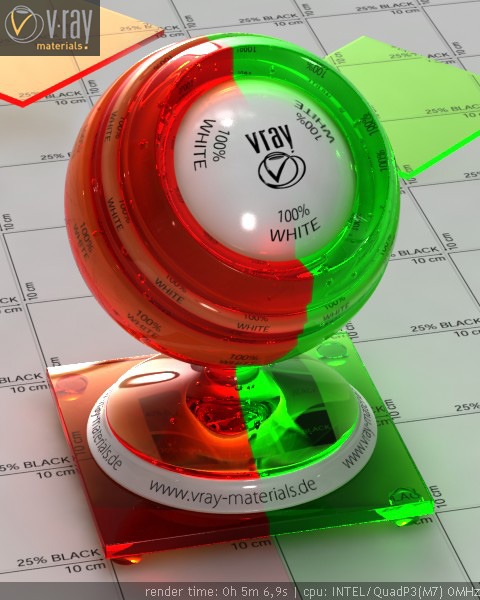
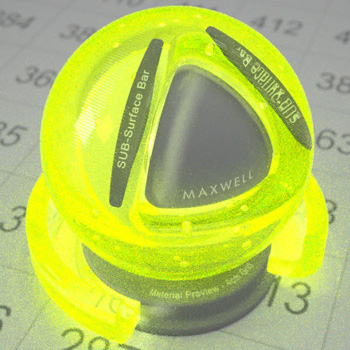
The V-Ray one is my favorite.
I actually spent a few hours in Kerkythea trying to create a realistic version for my own renders. I eventually figured it out.
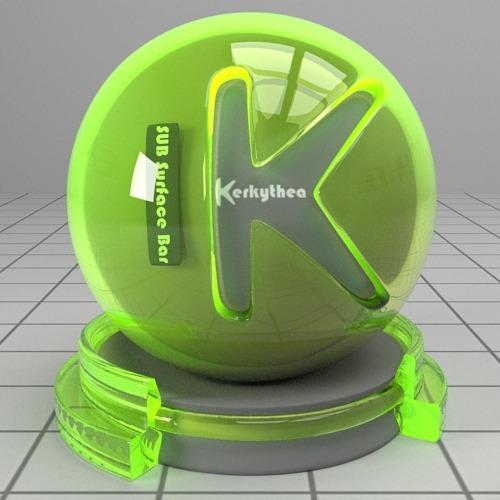
Here's how I did it:
I made a 'multi-layered' material which included a Dielectric Glass and a Phong Shader.
The glass was given a the IOR measured for acrylic and a slight tint to Refraction to colorize it throughout via a direct viewing angle.
I also provided a Fog absorption color to add coloring through the long paths.
The problem first off was that I noticed that the long paths yielded a darker color, or loss in light.
I then added the Phong shader to the layers. It has no data to define it except that I added some bright greenish/yellow coloring to both the Translucence and Transmitted values.
This really 'lit up' the material causing all sampled photons to practically illuminate the object. Transmitted Sampling was activated to add more light.
Doing this was surely breaking the law of energy conservation for this material, but for some reason, Kerkythea allowed the material to only be shown more through the long paths of the Dielectric. I even doubled the Phong layer to add more light.
Now, this material is assumed to be smooth all the way around and the effect is more evident only in bends and thinner edges.
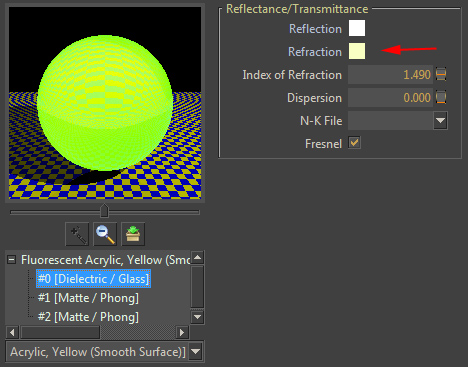
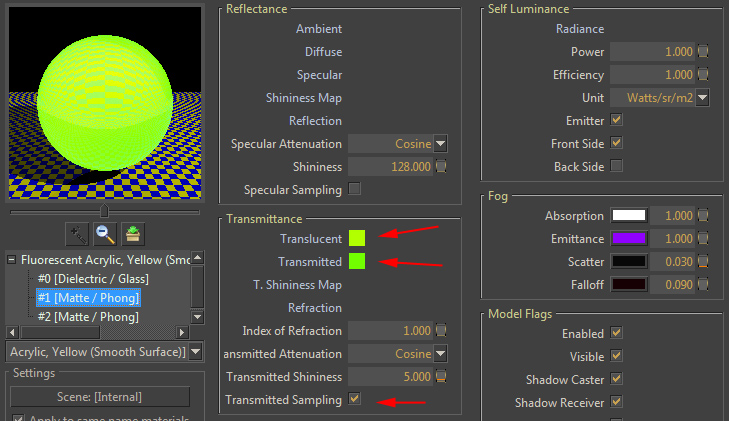
The effect of simulated fluorescent plastic contains two elements; the clear smooth stuff it's made out of and and the rough parts that most light emanates from.
To make this rough material, I use the same material as above but I diffused it up with a noise texture for the Bump as well as lower the Shininess level with the Specular Sampling activated, and the effect isn't really realistic unless you add a small amount of Emission (light) to the material to simulate the added converted-UV component.
Here are two attempts using this material:
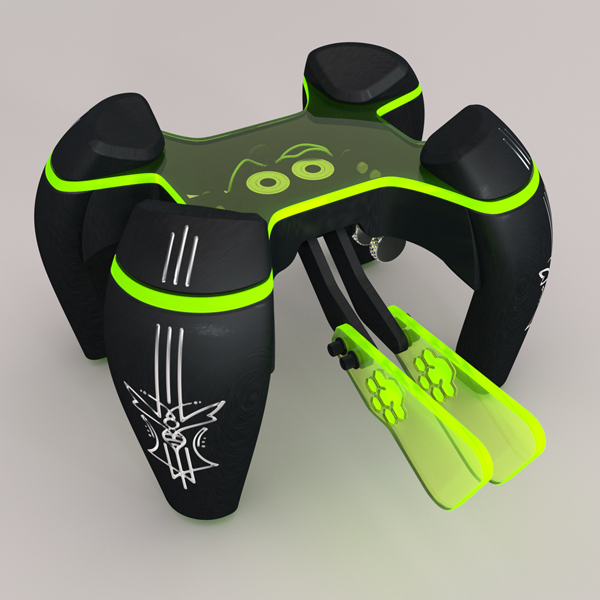

As for my caveat - here's where I could sure use help from any seasoned Thea Render users... or at least the sad truth.
Thea Render, though similar to the basic functions of Kerkythea, uses different 'heuristics' for their materials.
Sure you can layer them, but It appears that it will not mix clear glass and a solid shader in the same way to produce the viewing of the shader only through the long path of the glass.
I can see that other rendering programs are able to produce this effect so it may be that this might be a slight limitation to Thea Render.
Like I said, it's not a deal breaker. Thea appears to have fantastic realism and material construction strengths, so it wins in my book - plus, fluorescent plastic is NOT something I wish to use most of the time. I thought I'd share my little adventure in rendering.
From: OSTexo
Hello,
Thea Studio and plugins are on sale, Studio+Thea 4 Rhino is ~$270. In my opinion it's a great setup to create in MoI and drop into Rhino for rendering.
One option (if you can do this in KR) is to select a glossy transparent material, keep reflectance and transmittance as white, select the absorption color as the desired fluorescent and crank it up a bit. For your edges the only thing you need to change is the roughness value (mimicking the rougher cut edge surface, and perhaps crank up the absorption on that a bit more than the base material. There is no emitter used in this material, but I guess you could add a bit but I think doing that would sort of mess with what the material actually is. Here is a quick render I did to illustrate:
Hope it helps.

Image Attachments:
 FG.png
FG.png
From: joe (JOEHARRIS)
Love it!
From: Mike K4ICY (MAJIKMIKE)
Just playing around with SketchFab again...
50 mb limit for non-pay account, sooo all round edges are highly faceted, but the fluorescent plastic effect looks well.
From: mkdm
Welcome back Mike (K4ICY) !!!
Bye!










 The V-Ray one is my favorite.
The V-Ray one is my favorite.





![]() FG.png
FG.png